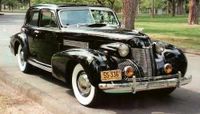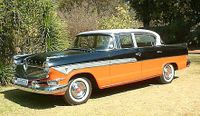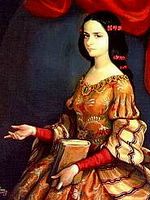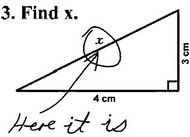Yank Tanks
Yesterday Zed and I watched Yank Tanks, a documentary by David Schendel, Blue Collar Films. "We believe in hand-made miracles" proclaims his lovely animated logo.
 When Fidel Castro turned to Communism in 1961 and the Cuban embargo began, there were 150,000 American cars on the island. In the 50s Cuba had imported more Cadillacs, Buicks, and DeSotos than any other nation; in 1958 Havana had more Cadillacs per capita than any city in the world.
When Fidel Castro turned to Communism in 1961 and the Cuban embargo began, there were 150,000 American cars on the island. In the 50s Cuba had imported more Cadillacs, Buicks, and DeSotos than any other nation; in 1958 Havana had more Cadillacs per capita than any city in the world."Forty years later, most of them are still on the road." To the Cubans, only a car from 1935 or earlier is a "classic." Models from the 50s and 60s - they're just cars.
 "They come in here with plants growing in them, but when they leave nobody recognizes them." Make magazine: "The Yank Tank hackers are the curators of the largest, living automobile museum in the world."
"They come in here with plants growing in them, but when they leave nobody recognizes them." Make magazine: "The Yank Tank hackers are the curators of the largest, living automobile museum in the world."The cars are gorgeous, painted in bold primary colors with any paint that comes to hand - "You use whatever. ... You can have green, blue, red, white, any color you want." The cars are air-conditioned with small portable fans mounted near the steering wheels.
The film-makers go in search of the best mechanics in Havana, and find them on every block. "Every Cuban is a mechanic"
- Eugenio O'Hallorans (the fifth Cuban generation of an Irish family), 77, makes chrome parts by hand, one by one, for any car. He designs them from photographs or partial rusted models, cuts them by hand, forms and bends them in machines he invented and built himself. "I have made everything in my life - when something ends I make something else."
The client has to gather the metal. All concur: "That's the owner's problem - he has to find it, buy it, bring it here." People with similar cars stop in the middle of the street to discuss their mutual inventories of spare parts. You can get metal on the streets. "Everything is from the streets, they don't sell it in a shop." Any piece of rusted metal, of any size, is a treasure and an immediately useful raw material.
When there is no metal, work stops till more "pieces" can be found.
- Arquimides - "now that I'm retired, instead of being lazy at home I repair cars. I don't need a shop - I work at people's homes ... we never give up." He is called an "Iron Doctor" and shows off a pickup truck he carved from a station wagon, with a decorative wrought-iron railing around the top.
- Billin manufactures a motorcycle for anyone who brings him a bicycle and a chainsaw motor - and who has the money. He also has a car made entirely by hand with a hand-chiseled copper plate to prove it ("hecho en casa"). "The back is a Morris, the body is a Bantan, the console is a piece of wood carved by hand." One day a man "came by pretending to know cars," looked at the label on the front, and said: "Liquid, that's a great car." Billin had taken the label off a blender.
He describes one of his brainstorms, a car that uses ordinary fuel on the highway and in town switches to electricity (made by a heat-sucking thermocoupler). He figures it would have very good gas mileage. - Chino runs a private auto business and the interviewer pretends to be perplexed. "We've understood that in Cuba there are no private companies - aren't you owned by the government?" "No, no, but if someone from the government comes with a car problem, I have to fix it. That's how it is. I don't have problems with the government ... it's worked for me." Government officials, though they don't pay for their jobs, come in with somewhat more raw materials than necessary. The surplus is immediately flipped into other jobs and everybody wins.
- One mechanic shows how chain link fences are dismantled and used to weld the scrap metal together.
 Augustin has a glass shop - he makes new windshields from shards of old ones in his handmade molds and melts them in a handmade kiln.
Augustin has a glass shop - he makes new windshields from shards of old ones in his handmade molds and melts them in a handmade kiln.- In one (entirely hand-designed and hand-built) shop, the most precious possession is an original owner's manual, with measurements of parts and chassis. "I keep this book in the house - it is in perfect condition - I wash my hands before I read it - it is sacred."
- Ito makes brake pads. "My work is hand-made - it is artisanal." He sifts asbestos, appallingly, with his bare hands, adds phenolic resin and graphite powder, compresses the mixture in a mold, glues it to the brakes, and bakes it in an oven. His mixture fills dents - "the brakes have been used so much they are deformed - this covers irregularities."
- One car is rigged to run on propane. Another has what appears to be a plastic milk jug as a gas tank. Another, the Chevy Volga, has an ancient Soviet engine melded into it. "We blend parts - if real parts were available, we'd be bored." Of a car with Russian, Chinese, and American parts, Zed marvels: "what a great product of the cold war."
 Maintenance of cars this old is a never-ending struggle, and keeping them on the road includes the struggle to pay for fuel - at the time the movie was made, gas was $4 a gallon in Cuba, while average income was $10 per month.
Maintenance of cars this old is a never-ending struggle, and keeping them on the road includes the struggle to pay for fuel - at the time the movie was made, gas was $4 a gallon in Cuba, while average income was $10 per month. Richard von Busack: Richard von Busack:Folk art often emerges straight out of poverty. What makes director David Schendel's documentary Yank Tanks one of the most easily recommended films at the upcoming Cinequest (Feb. 21-March 3) is that it doesn't strictly swoon over the poor life. Schendel observes something beautiful that happens despite poverty, not because of it. |
Illa has had his sumptuous golden 1950 Cadillac for 42 years. "Everyone in Cuba knows me and my car." He knows his car as well as he knows his own nose, he says, and he's taken the chassis out and repaired it himself, twice. He, an old man, has two incredible babes in his car, such is the magnetism of his ride. Or maybe they are his grand-daughters.
 It's obvious these cars are ardently adored. "It's better to lend the woman than the car." "This is my other woman." "It is love, it is longing." When the filmmakers ask the question: "would you pick your wife or your car?" a sheepish laugh is the usual answer. "It's a difficult question." "My car! You can find another woman later." "Both have thirty years with me - it is an equally balanced love."
It's obvious these cars are ardently adored. "It's better to lend the woman than the car." "This is my other woman." "It is love, it is longing." When the filmmakers ask the question: "would you pick your wife or your car?" a sheepish laugh is the usual answer. "It's a difficult question." "My car! You can find another woman later." "Both have thirty years with me - it is an equally balanced love."| Being a pessimist, I've thought that what Cuba has lived with these many decades may be part of our own futures. The defiant glee Cubans bring to their challenges fills me with hope; I can only pray we aren't too fat and lazy by then to search for the ingenuity within us that sustains the Cubans every day. "It is a difficult reality, but what happens here is that people always manage to get what they need. ... The Cuban invents a lot. If you don't invent, you don't have anything ... we have been living for 40, 42 years in the "Time of Invention." "My 1950 refrigerator still works perfectly. For other countries, that's not normal. Forty years of embargo teaches us to make miracles! Here the most stupid mechanic is an engineer. ... We've learned how to do something good. Cuba cannot be sunk." |
Technorati Tags: Cuba, Recycling, Embargo, Cars, Antique



 A few of my daughter
Melina's great posts:
A few of my daughter
Melina's great posts:








1 Comments:
Cuba: the ultimate recycler! I saw a program about this on the travel channel last yer. It is amazing how they keep those old cars running.
I guess we shouldn't complain about $2 per gallon of gas, considering what they have to pay!
Post a Comment
<< Home